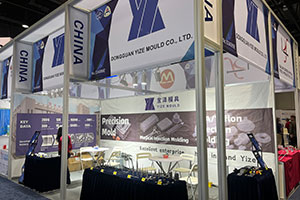The Environmental Impact of Packaging Materials for Tungsten Carbide Dies and Corresponding Countermeasures
In the context of the vigorous development of the global manufacturing industry today, tungsten carbide dies, with their outstanding characteristics such as high hardness and high wear resistance, have become […]
In the context of the vigorous development of the global manufacturing industry today, tungsten carbide dies, with their outstanding characteristics such as high hardness and high wear resistance, have become an indispensable key tool in modern manufacturing. They are widely applied in numerous fields including automobile manufacturing, electronic device production, and aerospace. However, the packaging materials used in their production and transportation processes have a significant impact on the environment, which is becoming increasingly prominent. With the continuous awakening and enhancement of global environmental awareness, how to effectively reduce the negative impact of packaging materials on the environment has become an urgent issue that the manufacturing industry needs to address. This article will conduct an in-depth exploration from multiple dimensions such as the types, environmental impacts, and environmental protection measures of packaging materials for tungsten carbide dies, aiming to provide practical reference solutions for reducing the environmental hazards of packaging materials.
Types and Characteristics of Packaging Materials for Tungsten Carbide Dies
The packaging materials for tungsten carbide dies are diverse, commonly including plastics, wood, paper products, and metals. They play an indispensable role in protecting the dies and facilitating transportation, but each also has its own environmental drawbacks.
Our factory business: carbide parts, mold parts, medical injection molds, precision injection molds, teflon PFA injection molding, PFA tube fittings. email: [email protected],whatsapp:+8613302615729.
Plastic Packaging Materials
Plastic packaging materials are widely used in the packaging of tungsten carbide dies due to their significant advantages such as being lightweight, waterproof, and moisture-proof. For example, some precision small tungsten carbide dies often use plastic foam for inner lining packaging, which can effectively cushion the vibrations during transportation and prevent the dies from rusting due to moisture. However, the non-degradability of plastics is their biggest environmental hazard. A large amount of plastic packaging materials accumulated in the environment for a long time not only occupies valuable land resources but also causes serious pollution to soil and water bodies. In addition, the production process of plastics emits a large amount of harmful gases and wastewater, such as volatile organic compounds (VOCs) and wastewater containing heavy metals. These pollutants can cause secondary pollution to the air and water sources, threatening ecological balance and human health.
Wood Packaging Materials
Wood packaging materials are characterized by low cost and ease of processing, and are often used for the packaging of large tungsten carbide dies. For instance, some large tungsten carbide stamping dies are packaged using wooden pallets and wooden boxes to provide sufficient support and protection. However, the over-exploitation of wood resources can lead to a sharp reduction in forest area, disrupt ecological balance, and trigger a series of environmental problems such as soil erosion and loss of biodiversity. At the same time, wood is prone to moisture absorption and deformation during storage and transportation, which not only affects the packaging effect but may also lead to die damage and increase resource waste.

Paper Product Packaging Materials
Paper product packaging materials are considered relatively environmentally friendly due to their recyclability and degradability. Many outer packaging boxes for tungsten carbide dies are made of cardboard, which is lightweight and environmentally friendly. However, the production process of paper products consumes a large amount of water resources and forest resources. According to statistics, producing one ton of paper requires about 100 tons of water and 17 adult trees. Moreover, the production process of paper products also generates wastewater, exhaust gas, and other pollutants. For example, the black liquor produced in the papermaking process contains a large amount of organic substances such as lignin, hemicellulose, and pigments. If not properly treated, it can cause serious pollution to water bodies.
Metal Packaging Materials
Metal packaging materials have high strength and durability and are suitable for some tungsten carbide dies with high packaging requirements. For example, some high-precision tungsten carbide cutting tools are packaged in metal boxes to prevent the dies from being collided and scratched during transportation. However, the mining and processing of metal resources generate a large amount of waste residue, wastewater, and other pollutants. The metal smelting process emits harmful gases such as sulfur dioxide and nitrogen oxides, which pollute the atmospheric environment. At the same time, metal waste is difficult to handle. If discarded randomly, it can cause long-term pollution to soil and water bodies and affect the stability of the ecosystem.
Multiple Environmental Impacts of Packaging Materials for Tungsten Carbide Dies
Resource Consumption Pressure
The production of packaging materials for tungsten carbide dies requires a large amount of raw materials such as plastics, wood, paper products, and metals. The mining and processing of these raw materials not only consume a significant amount of energy but also utilize a substantial amount of water resources. Taking plastic production as an example, producing one ton of plastic requires about 10 tons of oil and also generates a large amount of greenhouse gases such as carbon dioxide. The logging and processing of wood also consume a large amount of water resources and can lead to the destruction of forest ecosystems, affecting biodiversity and climate regulation functions.
Waste Pollution Dilemma
Packaging materials for tungsten carbide dies often become waste after use, causing serious pollution to the environment. Plastic packaging materials are difficult to degrade and can exist in the environment for hundreds of years, forming “white pollution”. A large amount of plastic waste accumulated in landfills not only occupies land resources but also releases harmful substances, polluting soil and groundwater. Although wood packaging materials are degradable, the accumulation of a large amount of waste wood also occupies land resources, and the degradation process generates methane and other greenhouse gases, exacerbating global warming. Although paper product packaging materials are recyclable, they also generate certain pollution during the production and recycling processes. The recycled paper products need to undergo processes such as deinking and bleaching, which consume a large amount of water resources and chemicals and generate wastewater and exhaust gas pollutants. Metal packaging materials are difficult to handle after being discarded. If not recycled properly, they can cause long-term pollution to the environment. The heavy metal elements in metal waste can seep into soil and water bodies, causing harm to the ecological environment and human health.
Transportation Pollution Hazards
During the transportation of tungsten carbide dies, packaging materials may cause pollution due to damage or leakage. For example, plastic packaging materials may be damaged due to bumps and collisions during transportation, releasing harmful substances such as plasticizers and stabilizers in plastic additives, which can pollute soil and water bodies. Wood packaging materials may get moldy due to moisture absorption, producing mycotoxins that not only affect the quality of the dies but also pollute the environment. Paper product packaging materials may lose their recycling value due to pollution. If discarded randomly, they can cause secondary pollution to the environment.
Innovative Measures to Reduce the Environmental Impact of Packaging Materials for Tungsten Carbide Dies
Promoting Environmentally Friendly Packaging Materials
Encouraging the use of degradable and recyclable environmentally friendly packaging materials is a key measure to reduce the environmental impact of packaging materials. Biodegradable plastics are a new type of environmentally friendly material that can be decomposed by microorganisms in the natural environment and eventually converted into carbon dioxide and water without causing pollution to the environment. For example, some enterprises have started to use polylactic acid (PLA) and other biodegradable plastics to package tungsten carbide dies, achieving good environmental protection effects. Recycled paper products are also an environmentally friendly choice. They can reduce dependence on forest resources, lower energy consumption, and environmental pollution. By recycling waste paper for reprocessing, high-quality paper product packaging materials can be produced, which not only saves resources but also protects the environment.
Optimizing Packaging Design
By optimizing packaging design and reducing the amount of packaging materials used, not only can packaging costs be reduced, but also pressure on the environment can be alleviated. Lightweight design is an effective method. For example, by improving the packaging structure and using thinner materials to achieve the same protective effect. Reducing the number of packaging layers is also a feasible strategy to avoid over-packaging and retain only the necessary packaging layers, which can both protect the dies and reduce material use. In addition, modular packaging design can also be adopted. According to different die sizes and shapes, combinations can be made to improve the versatility and flexibility of packaging and further reduce the waste of packaging materials.
Strengthening Waste Management
Establishing a perfect waste management system to classify, recycle, and treat the packaging waste of tungsten carbide dies is an important link in reducing environmental pollution. For recyclable packaging materials such as paper products and metals, special recycling channels should be established for classified recycling and reuse. For example, setting up recycling stations and encouraging enterprises and consumers to send waste packaging materials to the recycling stations, which are then processed and reprocessed by professional recycling enterprises. For packaging materials that are difficult to recycle, such as plastics, appropriate treatment methods such as incineration for power generation and landfilling should be adopted. During the incineration process, advanced incineration technologies should be used to reduce the emission of harmful gases; during the landfilling process, anti-seepage treatment should be carried out to prevent pollutants from seeping into groundwater and soil.
Raising Environmental Awareness
Strengthening environmental protection publicity and education and improving the awareness and importance of enterprises and consumers regarding environmentally friendly packaging materials are the foundations for promoting the development of environmentally friendly packaging. By conducting environmental protection training, holding environmental protection lectures, and distributing environmental protection publicity materials, environmental protection knowledge can be popularized among enterprises and consumers, and the advantages and usage methods of environmentally friendly packaging materials can be publicized. Guide enterprises and consumers to establish a green consumption concept and give priority to choosing environmentally friendly packaging materials, forming a good atmosphere of joint participation in environmental protection by the whole society. For example, some enterprises can encourage consumers to choose environmentally friendly packaging by marking environmental protection logos on product packaging and providing environmentally friendly packaging options, and jointly contribute to environmental protection.
Conclusion
The packaging materials for tungsten carbide dies have multiple impacts on the environment, involving resource consumption, waste pollution, and transportation pollution. To achieve sustainable development and reduce the negative impact of packaging materials on the environment, we must take a series of comprehensive measures, including promoting environmentally friendly packaging materials, optimizing packaging design, strengthening waste management, and raising environmental awareness. Only through the joint efforts of the whole society can we effectively reduce the environmental pollution and resource consumption caused by packaging materials for tungsten carbide dies and create a greener and more beautiful future for our planet.






